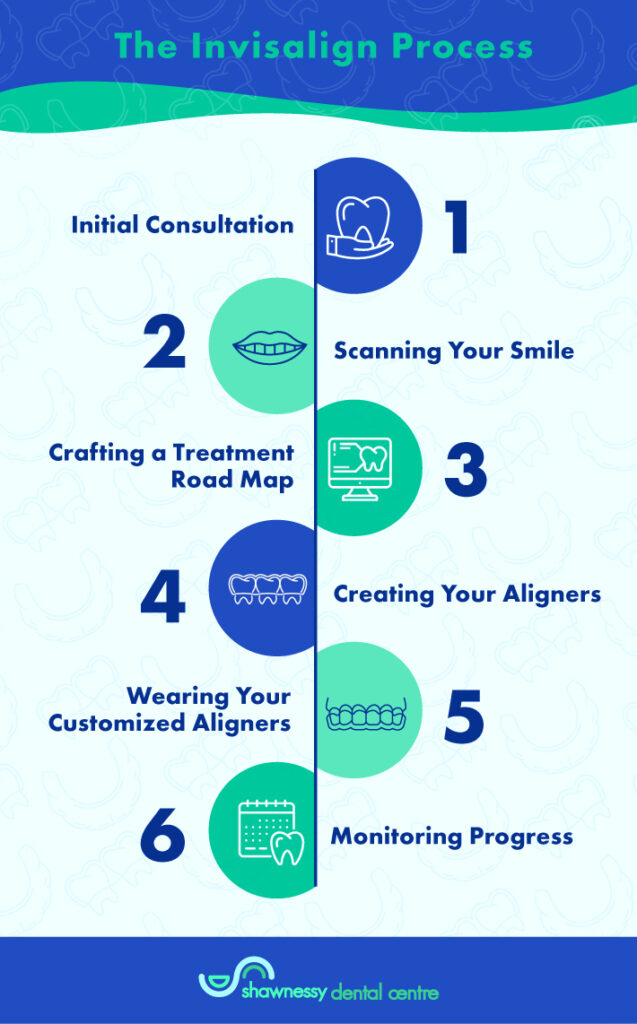Many people associate teeth straightening with metal wires, brackets, and constant visits to the orthodontist. Although traditional metal braces are reliable and effective, they may not be for everyone.
If braces don’t fit your lifestyle, Invisalign is a modern and discreet alternative to straighten mild to moderate teeth misalignment using a series of clear plastic aligners to gently shift your teeth.
Do I Need to Straighten My Teeth?
Straight teeth do more than enhance the appearance of your smile. They contribute to a healthy, functional bite, which affects your overall oral health.
What Is Malocclusion?
Malocclusion refers to crooked teeth or a poor bite. Issues like overbites or underbites can cause discomfort when eating or speaking, and in some cases, they can even cause chewing problems.
Unaddressed malocclusion can lead to dental complications, such as:
- Gum recession
- Gum injury
- Jaw pain
- Teeth grinding
- Tooth erosion
Misaligned teeth can also make it harder to brush and floss properly, potentially increasing the risk of cavities, gum disease, and bad breath.
Your dentist will typically recommend orthodontic solutions to straighten your teeth and help preserve your oral health.
What Is Invisalign?

The Invisalign system uses a series of clear aligners to address mild to moderate teeth misalignment. The aligners are virtually invisible, making them an appealing alternative to braces for anyone looking for a straighter smile without drawing attention to the process.
How Does Invisalign Work?
Invisalign requires time to slowly shift teeth into their optimal positions. To keep progress on track, you must wear the aligners for at least 22 hours a day.
The Invisalign Process

Every Invisalign journey begins with an initial consultation. Your dentist will evaluate your teeth, bite, and overall oral health. Once they determine that Invisalign is right for you, they can start the process of making your aligners:
- Scanning your smile: Invisalign’s iTero Element scanner can produce a series of detailed images of your teeth to create a 3D model of your smile.
- Crafting a road map: The 3D model of your smile is used to map out your treatment schedule. It can even visualize what your smile will look like after the treatment process.
- Creating your aligners: Each set of aligners is crafted to fit snugly and slowly straighten your teeth with your unique dental needs in mind.
- Wearing your Invisalign clear aligners: Once you receive your set of aligners, you’ll need to wear them for at least 22 hours a day. Depending on your dentist’s recommendation, you’ll switch to your next aligner every 1–2 weeks.
- Scheduling your follow-up appointments: Regular checkups help monitor your progress and adjust as necessary. Your dentist will likely give you a new set of aligners during your follow-up appointments.
The Benefits of Invisalign
Many patients with mild to moderate teeth misalignment opt for Invisalign because of its benefits, such as:
- Discreet appearance: The clear aligners are barely noticeable, making them a great choice for adults and teens who want a subtle approach to orthodontic treatment.
- Comfortable fit: Invisalign is made of smooth, BPA-free plastic, and treatments don’t require brackets and wires.
- Removability: Invisalign can be removed while eating, drinking, brushing, and flossing, so it won’t affect your diet or your oral hygiene routine.
- Predictable results: 3D scanning technology allows for accurate planning from start to finish.
- Versatility: Invisalign can address many different orthodontic concerns, such as overbites, underbites, crowded teeth, and excessive spacing.
What If You Have Severe Misalignment?
While Invisalign is effective for most mild to moderate alignment issues, complex alignment issues may require larger movements, rotation of teeth, or substantial bite corrections that Invisalign can’t effectively address with its gentler force.
Sometimes, Invisalign attachments can help with more complex tooth movement, but this can be costly.
Significant orthodontic demands will typically require the strength and versatility of traditional braces. Your dentist can determine the best solution for your specific dental care needs. They may even recommend a combination of braces and Invisalign to help you straighten your teeth efficiently and effectively.
Straighten Your Teeth with Confidence
Straight teeth can affect your oral health and your confidence. If you’re looking for a straighter, healthier smile, Shawnessy Dental Centre can help. Our team is dedicated to providing quality dental care to help you achieve your oral health goals.Contact us today to book your appointment. We’ll assess your smile and overall oral health to determine the best solution for your unique needs.


